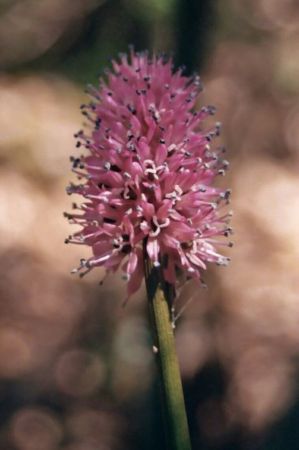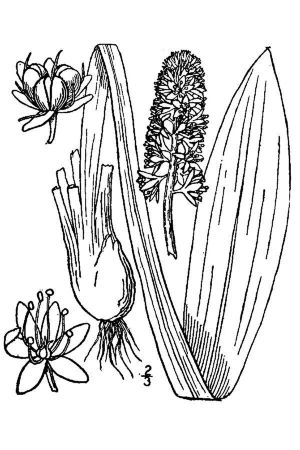 |

|
| Photo
by Renee Scagnelli |
Britton and Brown. See
credits below. |
| Botanical name: |
Helonias
bullata
|
| Common
name: |
Swamp
pink |
| Group: |
Monocot |
| Family: |
Liliaceae |
| Growth
Type: |
Forb/herb |
| Duration: |
Perennial |
| Plant
height: |
1'-2' |
| Flower
color: |
Bright
pink, lavender pink, or lilac, with blue stamens |
| Flower
size: |
Dense,
terminal spike; flowers 1 cm. wide |
| Flowering/fruiting time |
Flowers
early April to mid-May |
| Habitat: |
Atlantic
white cedar swamps and hardwood swamps |
| Range in
New Jersey: |
Swamps
of the Pine Barrens, Middle and Cape May districts. |
| Heritage rank if any |
State
rank is threatened; federally endangered, listed CMP. |
| Misc.: |
Leaves
are evergreen. Begins to bloom when the "spike is almost sessile in the
center of the rosette of narrow spatulate leaves, but the scape
lengthens rapidly" (Stone 341).
"Distribution
• This species historically ranged from
New York State to the southern Appalachian Mountains. The largest
percentage of extant groups is found in New Jersey but the species is
also locally abundant at other sites in the Mid-Atlantic region
(NatureServe 2001).
• Found in Georgia, North Carolina, South Carolina, Delaware,
Maryland, New Jersey, New York, and Virginia (WWF 1990)
Number Left
In 1990, there were over 65 populations
confirmed (population sizes ranging from 1 to 5,000 rosettes) in New
Jersey, the state with the highest concentration of populations
remaining (Peterson 1990).
Ecological Relationships
• Seeds have fatty appendages on them,
assumed to be eliasomes, suggesting that ant dispersal (myrmechochory)
may be a means of seed dispersal for the species. (Sutter 1982)
Current Research Summary
• Godt et al. (1995) measured the
genetic diversity of 15 populations and found greater diversity in some
of the smallest ones suggesting that they might be relict groups.
• Sutter (1984) published a status report on the species in the
southern Appalachians and described the species breeding system. Swamp
pink is self-compatible with prolific seed production. However,
browsing can reduce reproductive output and the poor dispersal and lack
of suitable sites for germination severely restrict recruitment.
Current Management Summary
The recovery plan for this species was
completed in 1991 and several tasks are in progress including research
on genetics, habitat requirements, the impact of disturbances, the
development of conservation plans, searches for additional sites and
the enforcement of regulations protecting swamp pink habitat (North
Carolina Ecological Services 2002). The USFWS and the EPA helped to
protect a population from hazardous waste remediation activities at a
Superfund site (North Carolina Ecological Services 2002). The Citizens
United to Protect the Maurice River and its Tributaries. Inc. has
funded research to locate populations near this NJ river (CU 2002).
Baltimore Washington International Airport has altered forest
management plans to protect a stand of swamp pink at the end of one of
their runways (McCord 1985). Several government agencies and
horticultural and nature groups have also been involved in monitoring
populations."
Center
for Plant Conservation
|
Resources: Adopt A Swamp Pink Population
US Fish & Wildlife Swamp Pink Species Account
Center for Plant Conservation Plant Profile
EFlora's Plant Profile
|
Not sure what a word means? Use Answers.com:
|
| Sources |
|
|
|
|
|
|